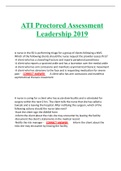Strategic management of technological innovation
Book of M.A. Schilling (4th edition)
Note: Parts with a blue lining around it, include additional information from the sheets.
,Chapter 1 – Introduction
1.1 The importance of technological innovation
Technological innovation: The act of introducing a new device, method, or material for application to
commercial or practical objectives.
Importance of technological innovation
Much of the rise in living standards is due to innovation;
Innovative performance is a crucial factor in determining competitiveness and national
progress;
It is now the single most important driver of competitive success:
o Product innovations help firms protect margins by offering new, and differentiated
features;
o Process innovations help make manufacturing more efficient.
Advances in information technology have enabled faster innovation (CAD/CAM).
Importance of innovation and IT have led to:
Shorter product life cycles
More rapid new product innovations
Greater market segmentation
1.2 The impact of technological innovation on society
Gross Domestic Product (GDP): total annual output of an economy measured by its final purchase
price (increases through technological innovations).
Externalities: Costs (or benefits) that are borne (or reaped) by individuals other than those responsible
for creating them (company building a park for their community to work in positive externality).
1.3 Innovation by industry: the importance of strategy
The innovation funnel
A rough sketch of NPD (New Product Development)
2
Strategic management of technological innovation. Melissa A. Schiling
,1.4 The strategic management of technological innovation
A firm’s innovation projects should align with its resources and objectives, leveraging its core
competencies and helping it achieve its strategic intent.
A firm’s organizational structure and control systems should encourage the generation of innovative
ideas while also ensuring efficient implementation.
A firm’s NPD process should maximize the likelihood of projects being both technically and
commercially successful. To achieve these things, a firm needs:
An in-depth understanding of the dynamics of innovation;
A well-crafted innovation strategy;
Well-designed processes for implementing the innovation strategies.
Forms of innovation: Product, service, and process.
3
Strategic management of technological innovation. Melissa A. Schiling
,PART 1 – Industry dynamics of technological innovation
Chapter 2 – Sources of innovation
Why innovate?
External drivers Internal drivers
Competition Improve profitability
New entrants Improve quality
Market drivers Improve cash flow
- Demand
- Social changes
- Economic forces
- Demographics
Lower cost
2.1 Overview
Innovation: The practical implementation of an idea into a new device or process.
Sources
Firms
The main producer of innovations because of their
resources and management systems. They also face
strong incentives to develop differentiating new
products and services, which may give them an
advantage over non-profit or government-funded
entities.
Universities
Individuals
Government-funded research
Private non-profits
4
Strategic management of technological innovation. Melissa A. Schiling
,Sources
Individuals (Users, employees, and outsiders)
Role of individual according to Schumpeter Garage model (i.e. start at home). Still going
strong because of:
o Growth of small firm sector;
o New organizational arrangements e.g. strategic alliances;
o Availability of financial support e.g. business angels;
o Role models.
Users: Lead users are ones who employ product on demanding cutting edge applications
and have lots of experience.
Outsiders: Provide a different perspectives and are not aware of paradigms. They challenge
existing assumptions, and have a broad range of external contacts. Not invented here
syndrome.
Corporations/Universities
Aim of corporations is new discoveries that lead to new products. Mass production.
Spill-overs
Where research by one firm ends up benefiting others. Likely to occur if ‘appropriability’ is
problematic. May be associated with a region. Often linked to staff mobility.
Process needs
Where a bottleneck occurs. Intense pressure builds to ‘cure’ the bottleneck. Very strong
incentive for innovation. Often potential for massive cost reduction.
Invention vs. Innovation
Invention: An idea, a sketch or model for a new or improved device, product, process or system. This
becomes an innovation when it is introduced to the market.
Innovation: The process and outcome of creation and commercialization of something new. It is about
finding new ways to do things and to obtain strategic advantage. It is the successful exploitation of
ideas. It is the first commercial application or production of a new product or process.
The process of diffusion of an innovation is the process of user acceptance and implementation.
5
Strategic management of technological innovation. Melissa A. Schiling
,2.2 Creativity
Creativity is the ability to generate new and useful ideas.
Ideas: something imagined or pictured in the mind. Innovation begins with the generation of new
ideas.
Reinvention: a product that is novel to the person who made it, but known to most everyone else.
Individual creativity
An individual’s creative ability is a function of
Intellectual abilities
Ability to look at problems unconventionally, analyse ideas, articulate to ideas to others, and
convince them of the idea;
Knowledge
Too little knowledge can result in little contribution, while too much knowledge can result in
not coming up with solutions that need a different perspective;
Thinking style
The most creative individuals prefer to think in novel ways of their own choosing and can
discriminate between important problems and unimportant ones;
Personality
Most important for creativity (self-efficacy is confidence in own capabilities, tolerance for
ambiguity, and willingness to overcome obstacles and take reasonable risks);
Motivation
Intrinsic motivation is most important;
Environment
Provides support and rewards for creative ideas.
Organizational creativity
The creativity of the organization is a function of creativity of
Individual creativity;
Variety of social processes that shape the way those individuals interact and behave;
Variety of contextual factors that shape the way those individuals interact and behave.
The most familiar method is the suggestion box.
Intranet: A private network, accessible only to authorized individuals. It is like the internet but operates
only within the organization.
2.3 Translating creativity into innovation
Innovation requires combining a creative idea with resources and expertise that make it possible to
embody the creative idea in a useful form.
6
Strategic management of technological innovation. Melissa A. Schiling
, The inventor
Personality traits of the inventor
Mastered basic tools and operations of the field in which they invent, but they have not
specialized solely in that field. They have pursued 2 or 3 fields simultaneously, permitting them
to bring different perspectives to each;
They are curious and more interested in problems than solutions;
They question the assumptions made in previous work in the field;
They often have the sense that all knowledge is unified. They seek global solutions rather than
local solutions and are generalists by nature.
Innovation by users
The users often know best what the flaws are and how they can be improved. They often have both a
deep understanding of their unmet needs and the incentive to find ways to fulfil them. Where
manufacturers innovate in order to make profit, users have no need to profit from the innovation.
Research and development by firms
Research can refer to
Basic research: Research targeted at increasing scientific knowledge for its own sake. It may
or may not have any long-term commercial application;
Applied research: Research targeted at increasing knowledge for a specific application or
need.
Development: Activities that apply knowledge to produce useful devices, materials, or processes.
Research and development: A range of activities that extend from early exploration of a domain to
specific commercial implementations. A firm’s R&D intensity has a strong positive correlation with its
sales growth rate, sales from new products and profitability.
Science-push (’50-’60): This approach assumed that innovation proceeded linearly from scientific
discovery, to invention, to engineering, then manufacturing activities, and finally marketing. Primary
source of innovation were discoveries in basic science that were translated into commercial
applications. Linear model emphasizes “supply side”.
Scientific discovery invention manufacturing marketing
Demand-pull model of R&D (‘65): Innovation is driven by the perceived demand of potential users.
Research staff would develop new products in efforts to respond to customer problems or suggestions.
Linear model emphasizes “demand side”. Critic: the model is too simplistic.
Customer suggestions invention manufacturing
7
Strategic management of technological innovation. Melissa A. Schiling











